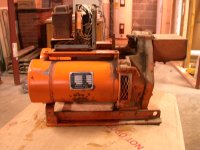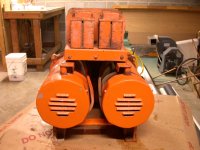dangier_VA
Silver Member
Had an occasion to use my pto generator due to a power outage a few days ago. Sounds like a bearing was failing in the brush end. It is an old Niagara Power (Generac), dual 7500 watt power heads for 15,000 watt capacity. Rated for 115/230 volts, 60 cycles at 3600 rpm (540 rpm pto speed).
In pulling the pto speed increaser apart, the large driven gear that drives each power head came off with the case. In order to not loose the armature locations, I marked them as they were. Both had turned some when the gear case was pulled apart as the teeth are cut an an angle on the gears. When I put the gear case together, my marks were a little off for the armatures to be exactly 180 degrees out to produce 230 volts in tandem. I lined up both armatures exactly 180 degrees out (My marks were about two teeth off on the driven gear). Today I test ran the generator and noticed the following: While running the pto speed to produce 60 cycles, the voltage outputs were 127/129 volts (hot to neutral-both legs), and 250 volts (hot to hot). Too high!!! These readings were taken while unit was under a 5000 watt resistive load.
Now the question--Were the armatures on purpose not at 180 degrees apart to derate the generator to the correct voltage? Guess I need to pull down and slip the gears a few teeth and try again.
I still have the bearing noise.... Bearing housing is worn larger than the bearing external diameter. Tried peening with a punch and need to do more.
In pulling the pto speed increaser apart, the large driven gear that drives each power head came off with the case. In order to not loose the armature locations, I marked them as they were. Both had turned some when the gear case was pulled apart as the teeth are cut an an angle on the gears. When I put the gear case together, my marks were a little off for the armatures to be exactly 180 degrees out to produce 230 volts in tandem. I lined up both armatures exactly 180 degrees out (My marks were about two teeth off on the driven gear). Today I test ran the generator and noticed the following: While running the pto speed to produce 60 cycles, the voltage outputs were 127/129 volts (hot to neutral-both legs), and 250 volts (hot to hot). Too high!!! These readings were taken while unit was under a 5000 watt resistive load.
Now the question--Were the armatures on purpose not at 180 degrees apart to derate the generator to the correct voltage? Guess I need to pull down and slip the gears a few teeth and try again.
I still have the bearing noise.... Bearing housing is worn larger than the bearing external diameter. Tried peening with a punch and need to do more.



